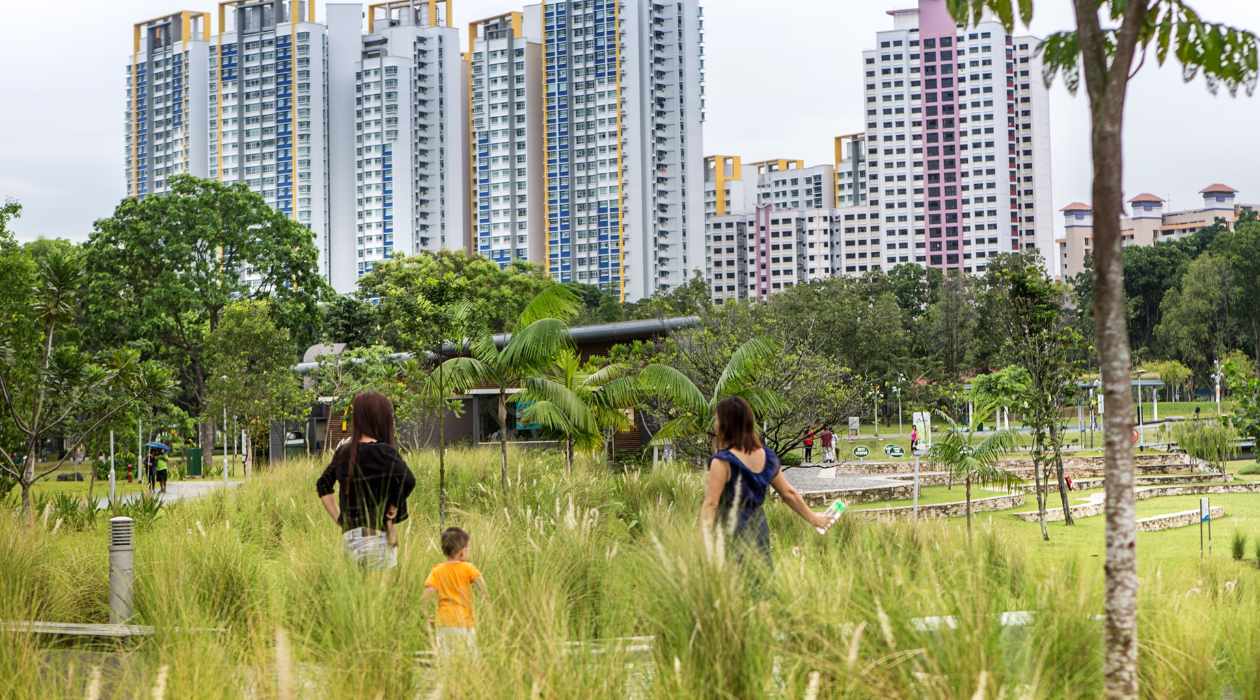Home>Garden Essentials>How To Increase Greenery In Cities


Garden Essentials
How To Increase Greenery In Cities
Modified: March 7, 2024
Discover effective strategies to create more green spaces in urban areas and increase the number of gardens in cities. Transform your concrete jungle into a lush paradise with our expert tips and insights.
(Many of the links in this article redirect to a specific reviewed product. Your purchase of these products through affiliate links helps to generate commission for Storables.com, at no extra cost. Learn more)
Introduction
Welcome to the concrete jungle – urban cities bustling with activity, towering buildings, and fast-paced lifestyles. While cities offer immense opportunities and conveniences, they often lack one crucial element: greenery. The absence of natural green spaces in cities can have detrimental effects on the well-being of its residents and the environment. However, there is a growing movement to increase greenery in cities, aiming to create a more sustainable and livable urban environment.
Greenery in cities refers to the presence of vegetation, such as trees, plants, and gardens, within urban areas. It can be achieved through various strategies, such as urban forestry, rooftop gardens, vertical gardens, pocket parks, and more. These initiatives not only beautify urban landscapes but also provide a wide array of benefits for both residents and the environment.
In this article, we will explore the benefits of greenery in cities, discuss the challenges faced in increasing green spaces, and delve into strategies to enhance the greenery quotient of urban areas.
Key Takeaways:
- Greenery in cities, such as trees, gardens, and parks, improves air quality, reduces urban heat, and supports mental well-being, creating healthier and more vibrant urban environments for residents.
- Challenges like limited space, cost, and maintenance need to be addressed, but by implementing strategies like tree planting, green walls, and urban agriculture, cities can overcome obstacles and create sustainable, resilient, and beautiful urban landscapes.
Benefits of Greenery in Cities
The presence of greenery in cities offers numerous advantages that contribute to the overall well-being of residents and the environment. Here are some of the key benefits:
- Improved air quality: Trees and plants act as natural air filters, helping to remove pollutants and improve the quality of the air we breathe. They absorb carbon dioxide and release oxygen through photosynthesis, thereby reducing the presence of harmful gases and improving air quality in urban areas.
- Reduced urban heat island effect: Urban areas tend to be several degrees hotter than rural areas due to the heat-absorbing properties of concrete and asphalt. Green spaces and vegetation can mitigate this heat island effect by providing shade, reducing surface temperatures, and creating a more comfortable microclimate.
- Enhanced mental well-being: Access to green spaces has been linked to improved mental health and well-being. Urban environments can be stressful, and exposure to nature has a calming effect on the mind, reducing stress, anxiety, and depression. Green spaces provide opportunities for relaxation, physical activity, and social interactions, contributing to better overall mental health.
- Biodiversity support: Urban green spaces can serve as habitats for a variety of plants, insects, birds, and other wildlife. They provide vital resources and shelter, promoting urban biodiversity and preserving ecological balance.
- Stormwater management: Green infrastructure, including vegetation and permeable surfaces, helps manage stormwater runoff by absorbing and filtering rainwater. This reduces the strain on drainage systems, mitigates the risk of flooding, and improves water quality by reducing the amount of pollutants entering water bodies.
- Energy conservation: Trees strategically planted around buildings can provide shade, reducing the need for air conditioning during hot summer months. They can also act as windbreaks, reducing wind-related heat loss during colder seasons. These energy-saving benefits contribute to reducing carbon emissions and promoting sustainability.
- Positive economic impact: Green spaces enhance property values, attract businesses and investments, and boost tourism. They create more pleasant and desirable urban environments, attracting residents and businesses, ultimately leading to economic growth and development.
These are just a few of the many benefits that greenery brings to cities. Increasing the presence of vegetation in urban areas is not only aesthetically pleasing but also crucial for creating sustainable and resilient cities that prioritize the well-being of their residents.
Challenges in Increasing Greenery
While the benefits of increasing greenery in cities are undeniable, there are several challenges that need to be addressed in order to successfully implement green initiatives. These challenges can include:
- Limited space: Urban areas are often cramped with limited available space for green infrastructure. Finding suitable locations and integrating green spaces can be a challenge, especially in densely populated cities where land is scarce.
- Cost: Establishing and maintaining green spaces and infrastructure can be costly. Funding for tree planting programs, maintenance of parks and gardens, and installation of green roofs can be a significant barrier to increasing greenery in cities, especially for cash-strapped municipalities.
- Infrastructure constraints: Existing infrastructure, such as buildings and roads, may pose challenges when trying to incorporate green spaces. Retrofitting buildings with green features, such as vertical gardens or rooftop gardens, can be technically complex and require careful planning and implementation.
- Climate limitations: Some cities face extreme weather conditions, such as high temperatures, strong winds, or limited rainfall, which can impact the survival and growth of vegetation. Choosing suitable plant species that are resilient to local climate conditions becomes crucial to ensure the success of greenery initiatives.
- Maintenance: Green spaces require regular maintenance to remain healthy and attractive. This includes watering, pruning, weeding, and pest control. Maintaining green infrastructure can be labor-intensive and costly, requiring skilled personnel and ongoing resources.
- Community engagement: Increasing greenery in cities requires the support and involvement of the local community. However, garnering community engagement and participation can be a challenge. Educating and encouraging residents to take ownership of green initiatives, such as community gardens or tree planting programs, is essential for their long-term success.
- Coordination and planning: Implementing green initiatives in cities requires coordination among various stakeholders, including government agencies, urban planners, community organizations, and the private sector. Aligning interests, establishing partnerships, and developing comprehensive plans are crucial for successful implementation.
Despite these challenges, cities around the world are embracing the importance of greenery and are finding innovative ways to overcome these obstacles. Through collaboration, creative solutions, and a shared vision, it is possible to increase greenery in cities and create more sustainable and livable urban environments.
Strategies to Increase Greenery in Cities
Increasing greenery in cities requires a multifaceted approach that encompasses various strategies and initiatives. Here are some effective strategies to increase greenery in urban areas:
- Urban Forestry: Planting and maintaining trees in urban spaces can provide numerous benefits. Trees improve air quality, reduce urban heat island effect, and enhance the aesthetic appeal of the city. Implementing tree planting programs and adopting proper tree care techniques can help increase the tree canopy cover in cities.
- Rooftop Gardens: Utilizing flat roofs and transforming them into green spaces can significantly increase greenery in cities. Rooftop gardens provide additional space for planting trees, shrubs, and flowers, improving air quality and reducing the urban heat island effect. These gardens also offer recreational spaces and opportunities for urban agriculture.
- Vertical Gardens: Vertical gardens, also known as green walls, are excellent solutions for cities with limited horizontal space. These living walls feature plants grown vertically on exterior or interior walls of buildings, adding greenery to urban landscapes and providing insulation. They can be designed as standalone structures or incorporated into existing buildings.
- Pocket Parks: Creating small green spaces within urban neighborhoods, also known as pocket parks, can provide accessible areas for relaxation, recreation, and community engagement. These parks can be created in vacant lots, underutilized spaces, or even by reclaiming small sections of streets. Pocket parks provide opportunities for greenery and social interaction in dense urban environments.
- Green Walls: Installing green walls, made up of climbing plants or vines, on the facades of buildings can significantly increase greenery in cities. These vertical gardens not only enhance the aesthetics but also help combat air pollution and improve the microclimate in the immediate vicinity.
- Urban Agriculture: Integrated urban agriculture programs can be implemented to increase greenery and promote sustainable food production. Rooftop gardens, community gardens, and vertical farming are effective ways to incorporate agriculture into urban landscapes, fostering community engagement and providing fresh produce.
- Community Gardens: Establishing community gardens allows residents to actively participate in the cultivation of plants and vegetables. These shared spaces not only provide greenery but also promote social interactions, education, and a sense of community ownership. Community gardens can be set up in vacant lots, schoolyards, or other available urban spaces.
- Tree Planting Programs: Government or community-led tree planting programs can significantly increase the number of trees in urban areas. These initiatives involve planting trees along streets, in parks, and on private properties to enhance greenery and improve the urban environment.
- Permeable Pavements: Incorporating permeable pavement systems, such as permeable concrete or paving stones, allows rainwater to infiltrate the soil rather than being directed into drains. This helps reduce the strain on drainage systems, promotes groundwater recharge, and provides an opportunity for planting and maintaining vegetation.
- Green Infrastructure: Implementing green infrastructure practices, such as bioswales, rain gardens, and green roofs, can maximize the use of vegetation to manage stormwater, reduce heat island effect, and improve air quality. These nature-based solutions integrate green spaces into the urban fabric, enhancing sustainability and resilience.
By employing these strategies, cities can increase greenery and create healthier, more sustainable, and livable urban environments. Each approach can be tailored to suit the specific needs and constraints of a particular city, promoting a harmonious coexistence between urban development and nature.
Urban Forestry
Urban forestry plays a vital role in increasing greenery in cities by focusing on the planting, care, and management of trees within the urban landscape. It involves strategic planning and implementation to maximize the benefits that trees provide to both the environment and the urban community.
Here are some key aspects of urban forestry:
- Tree Planting Programs: Urban forestry initiatives often begin with tree planting programs, where trees are strategically selected and planted in parks, along streets, and in other public spaces. These programs involve collaboration between local governments, community organizations, and volunteers to ensure the successful establishment of trees.
- Species Selection: Choosing the right tree species is essential for urban forestry. It’s important to consider factors such as the local climate, soil conditions, available space, and the desired benefits of the trees. Diverse tree species are preferable to increase biodiversity and reduce the risk of disease or pest outbreaks.
- Tree Care and Maintenance: Once trees are planted, ongoing care and maintenance are crucial for their long-term health and survival. This includes regular watering, mulching, pruning, and monitoring for pests and diseases. Proper tree care increases the likelihood of successful establishment and contributes to the overall resilience of the urban forest.
- Tree Preservation: Urban forestry also involves the preservation and protection of existing trees, especially those of significant cultural, historical, or ecological value. Tree preservation efforts may include implementing tree protection ordinances, conducting tree risk assessments, and incorporating tree preservation plans into urban development projects.
- Education and Outreach: Urban forestry programs often include educational initiatives to raise awareness and promote community engagement. This can involve workshops, seminars, and educational campaigns to teach residents about the importance of trees, proper tree care practices, and the benefits of urban forestry.
- Collaboration: Successful urban forestry requires collaboration between various stakeholders, including government agencies, community groups, arborists, and urban planners. Building strong partnerships and engaging the local community is essential to garner support, secure funding, and ensure the long-term success of urban forestry initiatives.
Urban forestry not only enhances the aesthetic appeal of cities but also provides numerous benefits. Trees help improve air quality by absorbing pollutants and releasing oxygen, reduce urban heat island effect by providing shade, and provide habitats for wildlife. They also offer recreational opportunities, enhance property values, and contribute to a healthier and more sustainable urban environment.
By implementing urban forestry practices, cities can create a greener and more livable urban landscape, making a positive impact on the well-being and quality of life of their residents.
Rooftop Gardens
Rooftop gardens, also known as green roofs, are innovative and sustainable solutions for increasing greenery in urban areas. Transforming flat rooftops into vibrant green spaces offers several benefits for the environment, buildings, and the community.
Here are some key aspects of rooftop gardens:
- Aesthetic Enhancement: Rooftop gardens add visual appeal to the urban landscape, creating a lush and green environment amidst the concrete jungle. The greenery provides a refreshing and tranquil atmosphere, offering a much-needed respite from the urban hustle and bustle.
- Improved Energy Efficiency: Green roofs act as insulating layers, helping to regulate indoor temperatures and reduce the need for excessive air conditioning or heating. The vegetation helps to absorb and block solar radiation, keeping the building cooler in hot weather and reducing energy consumption.
- Stormwater Management: Green roofs play a crucial role in managing stormwater runoff, especially in cities with limited open spaces. The vegetation and soil on the rooftop absorb rainwater, reducing the burden on stormwater infrastructure and minimizing the risk of flooding. Green roofs also filter pollutants from rainwater, resulting in improved water quality.
- Biodiversity: Rooftop gardens provide valuable habitats for birds, bees, butterflies, and other pollinators, helping to enhance urban biodiversity. By creating pockets of green spaces across rooftops, it supports the preservation and conservation of local flora and fauna, contributing to a healthier and more sustainable urban ecosystem.
- Food Production: Rooftop gardens can be used for urban agriculture, allowing for the production of fresh and local food in the heart of the city. Vegetables, herbs, and fruits can be grown in containers or raised beds, offering an opportunity for community engagement, education, and access to healthy and sustainable food.
- Social Spaces: Rooftop gardens provide additional space for social interaction, recreation, and relaxation in densely populated urban areas. They can be designed with seating areas, walking paths, and even recreational facilities, serving as community gathering spaces and promoting a sense of belonging and well-being among residents.
- Noise Reduction: The vegetation and growing media on rooftop gardens help absorb and reduce noise pollution from the surrounding environment. This can be particularly beneficial in busy urban areas with heavy traffic or noisy surroundings, creating a more peaceful and serene ambiance.
- Sustainability: Rooftop gardens contribute to the overall sustainability of cities by reducing the urban heat island effect, lowering energy consumption, mitigating stormwater runoff, and sequestering carbon dioxide. They support the goals of sustainable urban development by creating resilient and eco-friendly urban environments.
Rooftop gardens offer a creative and practical solution for increasing greenery in cities. Whether it’s on commercial buildings, residential complexes, or public structures, they bring numerous benefits that improve the well-being of residents, the environment, and the urban landscape as a whole.
Through adopting rooftop gardens, cities can not only beautify their skyline but also create sustainable and livable urban environments for generations to come.
Vertical Gardens
Vertical gardens, also commonly known as green walls, are innovative and space-efficient solutions for increasing greenery in urban areas. These living walls are created by vertically growing plants on exterior or interior walls of buildings, transforming them into vibrant and eco-friendly features.
Here are some key aspects of vertical gardens:
- Aesthetic Enhancement: Vertical gardens add a stunning visual element to buildings, turning bare walls into lush and vibrant displays of greenery. They provide a striking contrast to the concrete and glass structures of urban environments, creating a harmonious blend of nature and architecture.
- Improving Air Quality: Vertical gardens act as natural air filters, helping to improve the air quality in urban areas. The plants absorb carbon dioxide and release oxygen through photosynthesis, reducing the presence of harmful pollutants and enhancing the overall air quality.
- Temperature Regulation: The dense vegetation in vertical gardens helps to regulate indoor and outdoor temperatures. By shading the building’s surface, they reduce heat absorption, which can help to lower energy consumption and decrease the urban heat island effect.
- Noise Reduction: Vertical gardens can also serve as effective noise barriers, absorbing and deflecting sound waves. The dense foliage helps to buffer and reduce noise pollution from surrounding traffic or busy urban environments, creating a more peaceful and serene atmosphere.
- Maximizing Vertical Space: Vertical gardens are an excellent way to maximize limited space in urban areas. As they grow vertically, they take up minimal floor space while providing a substantial amount of greenery. This makes them ideal for both indoor and outdoor environments, allowing for the integration of greenery in areas where horizontal space may be limited.
- Improved Psychological Well-being: The presence of greenery has been shown to have positive effects on mental health and well-being. Vertical gardens provide a connection to nature, even in densely populated areas, offering a sense of tranquility and calmness. They contribute to reduced stress levels, increased focus, and improved overall psychological well-being.
- Biodiversity Support: Vertical gardens can serve as habitats for a variety of plants, insects, and birds, contributing to urban biodiversity. The diverse plant species and the microhabitats they create offer opportunities for wildlife to thrive in an otherwise concrete-dominated environment. This helps to restore ecological balance and promote a more sustainable urban ecosystem.
- Improved Building Performance: Vertical gardens can provide insulation, reducing a building’s energy needs for heating and cooling. The layer of vegetation can act as an additional thermal barrier, preventing heat gain in the summer and heat loss in the winter. This leads to improved energy efficiency and reduced carbon emissions.
Vertical gardens offer a unique and visually captivating way to introduce greenery into urban environments. Whether they are integrated into the facade of a building or used as standalone structures, they provide a multitude of benefits, from improving air quality and reducing noise pollution to enhancing biodiversity and creating more sustainable and livable cities.
By embracing vertical gardens, cities can transform their urban landscapes and create greener, healthier, and more visually appealing spaces for residents and visitors alike.
Pocket Parks
Pocket parks, also known as mini-parks or vest-pocket parks, are small-scale green spaces that bring nature and relaxation to the heart of urban neighborhoods. These compact parks are created in underutilized spaces, such as vacant lots, disused alleyways, or small pockets of land, providing a variety of benefits for residents and communities.
Here are some key aspects of pocket parks:
- Community Gathering Spaces: Pocket parks serve as valuable community gathering spaces, fostering social interactions and creating a sense of community. These small oases within the city encourage people of all ages to gather, relax, and engage with their neighbors, helping to build stronger bonds and cohesion within the community.
- Accessibility: One of the significant advantages of pocket parks is their accessibility. Due to their small size, they are easily accessible to nearby residents, providing a convenient green space where people can take a break from their daily routines and enjoy a moment of tranquility without the need to travel far.
- Recreational Opportunities: Despite their small footprint, pocket parks can be designed to accommodate a range of recreational activities. They can include seating areas, walking paths, playgrounds, fitness equipment, or even small sports courts, offering residents opportunities for physical activity and exercise within their neighborhood.
- Environmental Benefits: Pocket parks contribute to urban greening efforts and provide numerous environmental benefits. They help to reduce ambient air temperature, mitigate the urban heat island effect, and improve air quality. The vegetation in pocket parks also supports biodiversity by providing habitats for birds, insects, and other wildlife.
- Green Respite: In a bustling urban environment, pocket parks offer a green respite amidst the concrete jungle. They provide a serene and peaceful environment where people can relax, read a book, have a picnic, or simply enjoy nature’s beauty. The presence of greenery has been shown to have a positive impact on mental well-being, reducing stress and promoting a sense of calm.
- Transforming Underutilized Spaces: Pocket parks are a creative way to utilize underutilized spaces within the city. They can be developed in vacant lots, along sidewalks, or in former parking areas, transforming neglected areas into valuable green spaces that contribute to the overall aesthetics and livability of the neighborhood.
- Creative Design: Pocket parks offer an opportunity for creative and innovative design. Despite their limited space, they can incorporate landscaping features such as plants, flowers, trees, and water elements. Intelligent use of vertical space, such as trellises or green walls, can further maximize the greenery within the park.
- Community Ownership: Encouraging community involvement and ownership is vital for the success of pocket parks. Residents can participate in the planning, design, and maintenance of the park, fostering a sense of pride and responsibility. Community-led initiatives ensure that the park reflects the specific needs and interests of the local community.
Pocket parks bring the benefits of larger parks to neighborhoods that may have limited space for traditional green spaces. They offer a retreat from the urban environment, enhance community connections, and provide opportunities for recreation and relaxation. These small but impactful green spaces contribute to creating more vibrant, inclusive, and livable urban neighborhoods.
By incorporating pocket parks into the urban fabric, cities can utilize underutilized spaces and maximize the benefits of greenery, creating a more sustainable and connected urban environment.
Consider planting more trees, creating green spaces like parks and community gardens, and using rooftop gardens to increase greenery in cities. These efforts can help improve air quality, reduce urban heat island effect, and provide habitats for wildlife.
Green Walls
Green walls, also referred to as living walls or vertical gardens, are innovative and visually striking features that bring nature to the vertical surfaces of buildings and structures in urban areas. These vertical gardens can be attached to exterior walls or integrated into indoor spaces, offering a range of benefits for both the environment and the people who interact with them.
Here are some key aspects of green walls:
- Aesthetic Appeal: Green walls add a unique and vibrant aesthetic to buildings, transforming plain walls into lush, living tapestries. These vertical gardens provide a visually captivating element, making a striking impression and enhancing the overall beauty of urban landscapes.
- Improved Air Quality: Green walls act as natural air filters, helping to improve air quality in urban areas. The plants in the walls absorb carbon dioxide and release oxygen through photosynthesis, reducing the presence of pollutants and enhancing the overall air quality for both indoor and outdoor spaces.
- Noise Reduction: The plants and growing media of green walls can help absorb and deflect sound waves, thereby reducing noise pollution. By acting as a natural sound barrier, green walls contribute to creating more peaceful and tranquil environments, particularly in busy urban areas.
- Energy Efficiency: Green walls provide insulation for buildings, helping to regulate indoor temperatures and reduce energy consumption. By acting as an additional layer of thermal protection, these living walls can reduce the need for heating and cooling, leading to energy savings and lower carbon emissions.
- Urban Heat Island Mitigation: Green walls help mitigate the urban heat island effect by shading and cooling the vertical surfaces of buildings. This reduces the absorption of heat and helps to create a more comfortable microclimate in urban areas, providing relief from soaring temperatures during hot seasons.
- Biodiversity Support: Green walls can provide habitats for a variety of plant species, insects, and birds, supporting urban biodiversity. These vertical gardens help to compensate for the loss of natural habitats due to urbanization, contributing to the preservation of a diverse range of flora and fauna within the city.
- Psychological Well-being: The presence of greenery has been shown to have a positive impact on mental health and well-being. Green walls create a connection with nature in urban environments, providing a calming and rejuvenating effect that reduces stress and enhances the overall psychological well-being of individuals.
- Space Optimization: Green walls offer a unique solution for adding greenery to urban spaces with limited ground area. By utilizing vertical space, they maximize the benefits of vegetation without compromising valuable ground space. This makes green walls ideal for both indoor and outdoor environments, offering versatility and flexibility in their implementation.
Green walls exemplify the harmonious integration of nature and architecture in urban landscapes. They provide a range of benefits, from enhancing aesthetics and improving air quality to reducing noise pollution and mitigating urban heat island effect. Moreover, these vertical gardens bring a sense of tranquility and well-being to often bustling and concrete-dominated environments.
By embracing green walls, cities can create more sustainable, visually captivating, and livable urban spaces that prioritize the well-being of their residents and the environment.
Read more: How To Make Greenery Tomte With Greenery
Urban Agriculture
Urban agriculture is a practice that involves growing, processing, and distributing food within urban areas. It encompasses a variety of techniques and approaches, from rooftop gardens and community plots to vertical farming and hydroponics. Urban agriculture has gained popularity as a means to increase greenery in cities while promoting local food production, environmental sustainability, and community engagement.
Here are some key aspects of urban agriculture:
- Local Food Production: Urban agriculture allows for the cultivation of fresh produce in the heart of the city. By growing fruits, vegetables, herbs, and even raising small livestock, urban agriculture helps to reduce dependence on long-distance food transportation and supports the production of locally sourced, nutritious food.
- Enhancing Food Security: Urban agriculture contributes to food security by providing an additional source of fresh food within urban communities. It reduces reliance on external food supply chains and increases access to affordable and healthy produce, particularly in areas with limited access to supermarkets or fresh food markets.
- Sustainable Land Use: Urban agriculture optimizes the use of underutilized spaces in cities, such as rooftops, balconies, vacant lots, and community gardens. By repurposing these areas for food production, urban agriculture helps to combat urban sprawl and promotes a more efficient use of land resources.
- Ecological Benefits: Urban agriculture practices, such as organic farming and permaculture, prioritize sustainable and environmentally friendly techniques. These include reducing chemical pesticide usage, practicing water conservation, composting organic waste, and promoting biodiversity. Urban farms can serve as habitats for pollinators, contribute to soil regeneration, and improve local ecosystem health.
- Community Engagement and Education: Urban agriculture fosters community engagement and collaboration. Community gardens and urban farms provide a space for residents to come together, learn from one another, and actively participate in the cultivation of food. They serve as platforms for sharing knowledge, nurturing social connections, and promoting healthy lifestyle choices.
- Economic Opportunities: Urban agriculture can create economic opportunities through the sale of locally grown produce, value-added products, or by offering urban farming-related services. It supports small-scale entrepreneurship and can contribute to job creation in areas such as urban farming, farmers markets, food processing, and distribution.
- Educational Initiatives: Urban agriculture provides valuable educational opportunities, particularly for children and young adults. School gardens and urban farm partnerships can teach valuable skills such as gardening, nutrition, and environmental stewardship. These initiatives help to cultivate a deeper understanding and appreciation for food, nature, and sustainability.
- Health and Well-being: Engaging in urban agriculture activities has numerous physical and mental health benefits. It promotes outdoor physical activity, encourages a diet rich in fresh produce, and offers a sense of accomplishment and connection with nature. Urban agriculture also provides opportunities for stress reduction and therapeutic benefits, contributing to overall well-being.
Urban agriculture presents a transformative approach to urban living by integrating food production into the fabric of cities. It enables individuals and communities to actively participate in the food system, fostering environmental sustainability, social cohesion, and improved food security and nutrition.
By embracing urban agriculture, cities can create more resilient and self-sufficient communities while increasing greenery and promoting sustainable and healthy living.
Community Gardens
Community gardens are vibrant and inclusive spaces where individuals come together to cultivate plants, vegetables, and herbs collectively. These shared green spaces, often located on public or privately-owned land, provide numerous social, environmental, and health benefits to the participants and the surrounding community.
Here are some key aspects of community gardens:
- Community Engagement: Community gardens serve as a focal point for community engagement, bringing people of all backgrounds together. Participants collaborate, learn from one another, and share their gardening knowledge and experiences. This promotes social interactions, builds stronger connections, and fosters a sense of belonging and community pride.
- Local Food Production: One of the primary objectives of community gardens is to grow fresh and nutritious food locally. Participants have the opportunity to cultivate a variety of fruits, vegetables, and herbs, ensuring access to affordable and healthy produce. Community gardens contribute to food security by reducing reliance on external food sources and promoting self-sufficiency within the community.
- Education and Skill Building: Community gardens provide a valuable platform for hands-on learning, offering participants the opportunity to acquire gardening skills, learn about organic farming practices, and gain a deeper understanding of environmental stewardship. Participants can share their knowledge, mentor each other, and promote sustainable gardening techniques within the community.
- Environmental Benefits: Community gardens contribute to urban greening efforts and have positive environmental impacts. They create green spaces in urban areas, increasing biodiversity and providing habitats for wildlife. These gardens also promote sustainable gardening practices, such as composting, water conservation, and organic pest control, minimizing the use of chemicals and reducing the overall ecological footprint.
- Physical and Mental Health: Engaging in community gardening activities has numerous health benefits. The physical act of gardening provides exercise and promotes overall well-being. Being outdoors, interacting with nature, and experiencing the therapeutic benefits of gardening can reduce stress, improve mental health, and enhance the quality of life for participants.
- Inter-generational Connections: Community gardens offer a unique opportunity for inter-generational connections. Older individuals can share their wisdom and gardening experience, while younger participants learn from their elders. These gardens become spaces for storytelling, knowledge transfer, and the passing down of gardening traditions, strengthening community bonds across different age groups.
- Beautification and Sense of Pride: Community gardens enhance the aesthetics of neighborhoods and contribute to the overall visual appeal of the community. They transform unused or neglected spaces into vibrant and colorful gardens, creating a sense of pride among participants and inspiring neighboring residents to take care of their surroundings. Beautiful community gardens foster a sense of community ownership and promote a cleaner and more attractive urban environment.
- Food Justice and Equity: Community gardens play a critical role in advocating for food justice and equity. They provide access to fresh produce in communities where healthy food options are limited, contributing to addressing issues of food deserts and food inequality. Community gardens often prioritize equity and ensure that everyone has an opportunity to participate, regardless of income or background.
Community gardens create a unique space where people can connect with nature, foster community bonds, grow their own food, and promote sustainable living practices. These shared green spaces not only provide tangible benefits like access to fresh produce but also contribute to the overall well-being and resilience of the community.
By supporting and establishing community gardens, cities can empower residents to actively engage in food production, environmental stewardship, and community building, ultimately creating healthier, more connected, and sustainable urban neighborhoods.
Tree Planting Programs
Tree planting programs are essential initiatives that aim to increase the tree canopy cover in cities. These programs involve strategic planning, community engagement, and the systematic planting and maintenance of trees in urban areas. Tree planting programs offer a multitude of benefits for the environment, human health, and the overall well-being of urban communities.
Here are some key aspects of tree planting programs:
- Improved Air Quality: One of the primary benefits of tree planting programs is the improvement of air quality. Trees act as natural air filters, absorbing carbon dioxide and other pollutants while releasing oxygen. They help to reduce the presence of harmful gases, improve air quality, and mitigate the impact of air pollution on human health and the environment.
- Urban Heat Island Mitigation: Tree planting programs play a significant role in mitigating the urban heat island effect. Trees provide shade and cool the surrounding areas through evapotranspiration. They reduce surface temperatures, lower energy consumption for cooling buildings, and create a more comfortable and livable urban microclimate.
- Enhanced Aesthetics and Visual Appeal: Trees contribute to the aesthetic appeal of urban landscapes. They soften the harshness of concrete and provide a natural beauty that enhances the overall visual appeal of cities. The presence of trees improves the quality of urban spaces, making them more inviting and enjoyable for residents and visitors alike.
- Biodiversity Support: Tree planting programs help to support urban biodiversity. Trees provide habitats for birds, insects, and other wildlife, promoting ecological balance within urban environments. By increasing the variety of tree species planted, tree planting programs can encourage a diverse range of wildlife and contribute to the preservation of local ecosystems.
- Stormwater Management: Trees play a crucial role in managing stormwater runoff. They help to absorb rainfall, reduce soil erosion, and filter pollutants before water enters water bodies. Tree roots also improve soil structure, increasing its capacity to retain water. Tree planting programs contribute to sustainable stormwater management, reducing the strain on drainage systems and improving water quality.
- Community Engagement and Volunteerism: Tree planting programs provide opportunities for community engagement and volunteerism. Residents can actively participate in planting and caring for trees, fostering a sense of community ownership and pride. Tree planting events and workshops also educate the community about the benefits of trees and the importance of environmental stewardship, encouraging a culture of environmental responsibility.
- Shade and Energy Conservation: Trees strategically planted around buildings provide shade, reducing the need for excessive air conditioning during hot summer months. They act as natural barriers to wind, reducing heat loss during colder seasons. This energy conservation helps to decrease carbon emissions and promote sustainability in urban areas.
- Health and Well-being: Trees have a positive impact on human health and well-being. They provide opportunities for outdoor recreation, physical activity, and relaxation, contributing to improved mental health and stress reduction. The presence of trees in urban environments has been linked to reduced rates of respiratory illnesses, improved cognitive function, and increased overall quality of life.
Tree planting programs have the power to transform urban environments, creating greener and healthier cities for present and future generations. By engaging communities, prioritizing strategic planting, and ensuring proper maintenance, these programs can significantly improve the well-being of urban communities and the overall sustainability of cities.
Through tree planting programs, cities can embrace the many benefits of trees, transform their urban landscapes, and create more resilient and livable environments.
Permeable Pavements
Permeable pavements are sustainable and innovative alternatives to traditional impermeable surfaces such as concrete or asphalt. These pavements are designed to allow the infiltration of stormwater into the ground, reducing stormwater runoff and the strain on drainage systems. Permeable pavements offer several environmental, social, and economic benefits, making them a valuable strategy for increasing greenery in cities.
Here are some key aspects of permeable pavements:
- Stormwater Management: Permeable pavements effectively manage stormwater by allowing rainwater to infiltrate into the ground. This natural filtration process helps to recharge groundwater, reducing the potential for flooding and alleviating the burden on stormwater management infrastructure.
- Reduced Urban Heat Island Effect: Permeable pavements contribute to reducing the urban heat island effect, which is the elevated temperature in urban areas compared to surrounding rural areas. By allowing rainwater infiltration, these pavements help to cool the surface temperature, creating a more comfortable and cooler urban environment.
- Improved Water Quality: Permeable pavements filter rainwater as it passes through the pavement surface and the underlying layers. This filtration process removes pollutants and contaminants, improving the quality of water that enters water bodies such as rivers, lakes, and streams.
- Groundwater Recharge: Whereas traditional pavements create impermeable surfaces that prevent rainwater from infiltrating the ground, permeable pavements allow water to recharge the groundwater. This helps to maintain a sustainable water supply and can help replenish local aquifers.
- Increase Greenery Opportunities: By promoting rainwater infiltration, permeable pavements create opportunities for planting vegetation. Green spaces can be incorporated into the pavement design, allowing for the growth of trees, shrubs, and other plants. This increases urban greenery, enhances aesthetics, and provides additional environmental benefits.
- Reduced Flooding Risk: Permeable pavements help to mitigate the risk of flooding during intense rain events. By allowing rainwater to infiltrate the ground locally, they reduce the volume of runoff flowing into stormwater systems. This promotes more controlled drainage and reduces the potential for overwhelming drainage infrastructure.
- Improved Pedestrian Comfort: Permeable pavements are designed to be more comfortable for pedestrians. They often have a porous surface that allows for better drainage and reduces the pooling of water on the pavement, minimizing slip and fall hazards. This enhances the safety and usability of sidewalks, walkways, and public spaces.
- Sustainability and Longevity: Permeable pavements are a sustainable choice for urban infrastructure. They have a longer lifespan compared to traditional pavements and require less maintenance over time. Additionally, they contribute to reducing the heat island effect, improving air and water quality, and promoting sustainable urban development.
Permeable pavements offer a range of benefits that contribute to creating greener, more sustainable cities. By integrating permeable pavements into urban designs, cities can actively manage stormwater, reduce flooding risks, improve water quality, enhance pedestrian comfort, and increase opportunities for urban greenery.
Through the implementation of permeable pavements, cities can optimize their infrastructure to create resilient and environmentally friendly urban environments for the present and future generations.
Read more: How To Increase Bass On Alexa
Green Infrastructure
Green infrastructure refers to a network of natural or nature-based elements strategically integrated into the built environment to provide various environmental, social, and economic benefits. It involves the incorporation of green spaces, vegetation, and sustainable stormwater management practices to create resilient and sustainable urban landscapes. Green infrastructure promotes the coexistence of nature and human activities, contributing to a healthier and more livable urban environment.
Here are some key aspects of green infrastructure:
- Stormwater Management: Green infrastructure utilizes nature-based solutions to manage stormwater runoff. Features such as bioswales, rain gardens, and constructed wetlands help to capture, retain, and filter rainwater, reducing the strain on conventional stormwater infrastructure and improving water quality.
- Urban Heat Island Mitigation: Green infrastructure helps to combat the urban heat island effect. By incorporating vegetation, green roofs, and canopy cover, it provides shade and cooling, reducing surface temperatures and creating more comfortable microclimates in urban areas.
- Biodiversity Conservation: Green infrastructure supports urban biodiversity by providing habitats for a variety of plant and animal species. Green spaces, parks, and natural corridors help connect fragmented habitats, promoting the movement of wildlife and enhancing ecological balance in urban environments.
- Air Quality Improvement: Green infrastructure contributes to better air quality by capturing air pollutants, such as carbon dioxide and fine particulate matter, through the photosynthetic process of plants. Vegetation acts as natural air filters and helps to reduce the negative impacts of air pollution on human health and the environment.
- Enhanced Psychological Well-being: Access to green infrastructure has positive effects on mental health and well-being. Spending time in green spaces, engaging with nature, and participating in outdoor activities can reduce stress, anxiety, and depression, enhancing overall quality of life and fostering mental well-being.
- Flood Mitigation: Green infrastructure plays a crucial role in flood mitigation by absorbing and storing excess rainwater. Features like green roofs, permeable pavements, and rain gardens help to reduce the volume and velocity of stormwater runoff, minimizing the risk of flooding during heavy rain events.
- Energy Conservation: Green infrastructure contributes to energy conservation by providing shade, reducing the need for air conditioning in summer months, and acting as windbreaks, reducing heat loss during winter months. These energy-saving benefits promote sustainability and reduce carbon emissions.
- Community Engagement and Social Cohesion: Green infrastructure encourages community participation and engagement. Public parks, community gardens, and open green spaces provide opportunities for social interactions, recreation, and events, fostering a sense of community cohesion, pride, and well-being.
- Economic Benefits: Green infrastructure has economic advantages for cities. It enhances property values, attracts businesses, supports tourism, and creates jobs in the development and maintenance of green spaces. Additionally, it can reduce healthcare costs by improving public health and reducing the effects of air pollution.
Green infrastructure offers a holistic and integrated approach to urban planning, placing importance on the coexistence of human activities and nature. By incorporating green spaces and sustainable practices into urban landscapes, cities can create more resilient, sustainable, and enjoyable environments for their residents.
Through the implementation of green infrastructure, cities can not only improve environmental conditions but also enhance the overall quality of life, promote community well-being, and foster a more sustainable and resilient urban future.
Conclusion
Increasing greenery in cities is crucial for creating sustainable, resilient, and livable urban environments. By incorporating various strategies such as urban forestry, rooftop gardens, vertical gardens, pocket parks, green walls, urban agriculture, community gardens, tree planting programs, permeable pavements, and green infrastructure, cities can transform their landscapes, improve the quality of life for residents, and mitigate the environmental challenges associated with urbanization.
Greenery in cities offers a multitude of benefits, including improved air quality, reduced urban heat island effect, enhanced mental well-being, biodiversity support, stormwater management, energy conservation, and positive economic impact. These benefits contribute to a healthier, more sustainable, and vibrant urban environment.
However, increasing greenery in cities is not without its challenges. Limited space, cost, infrastructure constraints, climate limitations, maintenance requirements, community engagement, and coordination and planning are all factors that need to be carefully addressed and overcome to successfully implement green initiatives.
It is essential for cities to prioritize the implementation of these strategies and engage in comprehensive planning and coordination. Collaborating with local communities, partnering with government agencies, and seeking private sector involvement will ensure the success and long-term sustainability of green initiatives.
By embracing greenery in cities, we can create urban landscapes that prioritize human health, biodiversity, environmental sustainability, and community well-being. With careful planning, community engagement, and innovative design, cities can transform into resilient and vibrant spaces where nature and urban life coexist harmoniously.
Now is the time to seize the opportunity to increase greenery in our cities, creating a more sustainable and beautiful future for generations to come.
Frequently Asked Questions about How To Increase Greenery In Cities
Was this page helpful?
At Storables.com, we guarantee accurate and reliable information. Our content, validated by Expert Board Contributors, is crafted following stringent Editorial Policies. We're committed to providing you with well-researched, expert-backed insights for all your informational needs.













0 thoughts on “How To Increase Greenery In Cities”